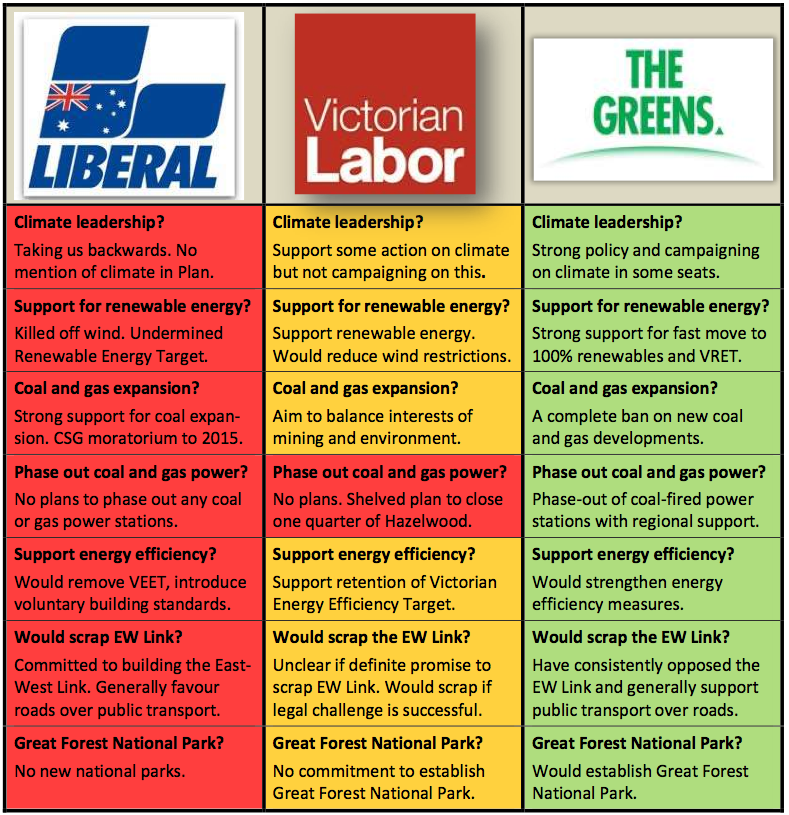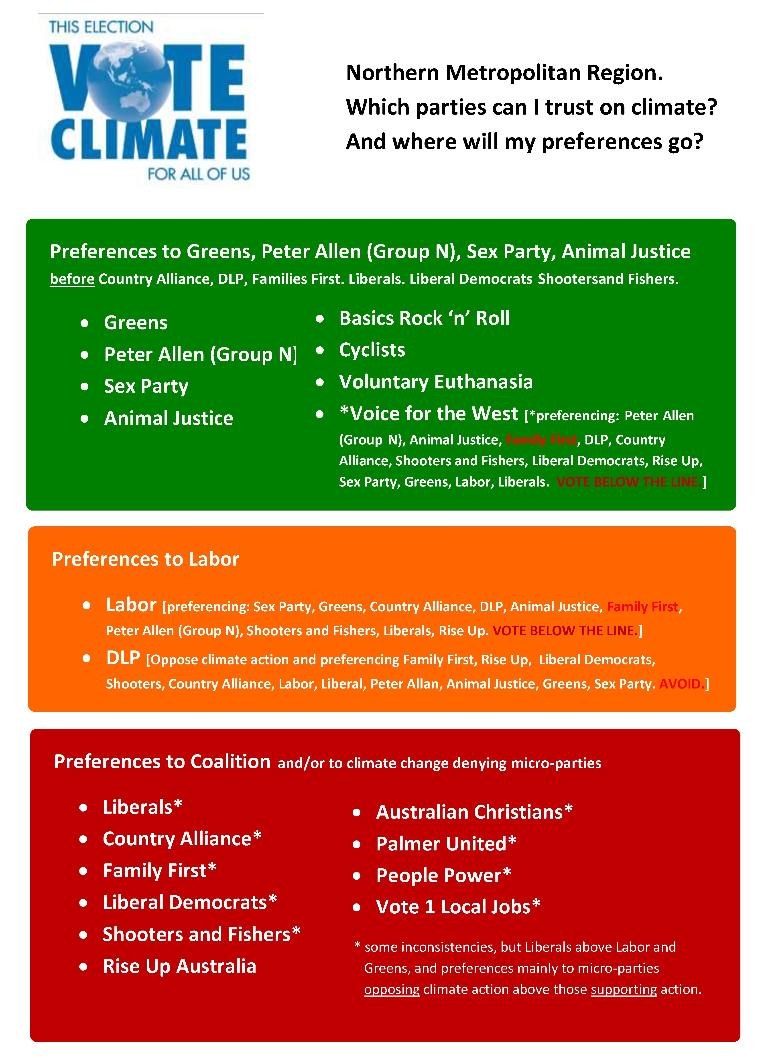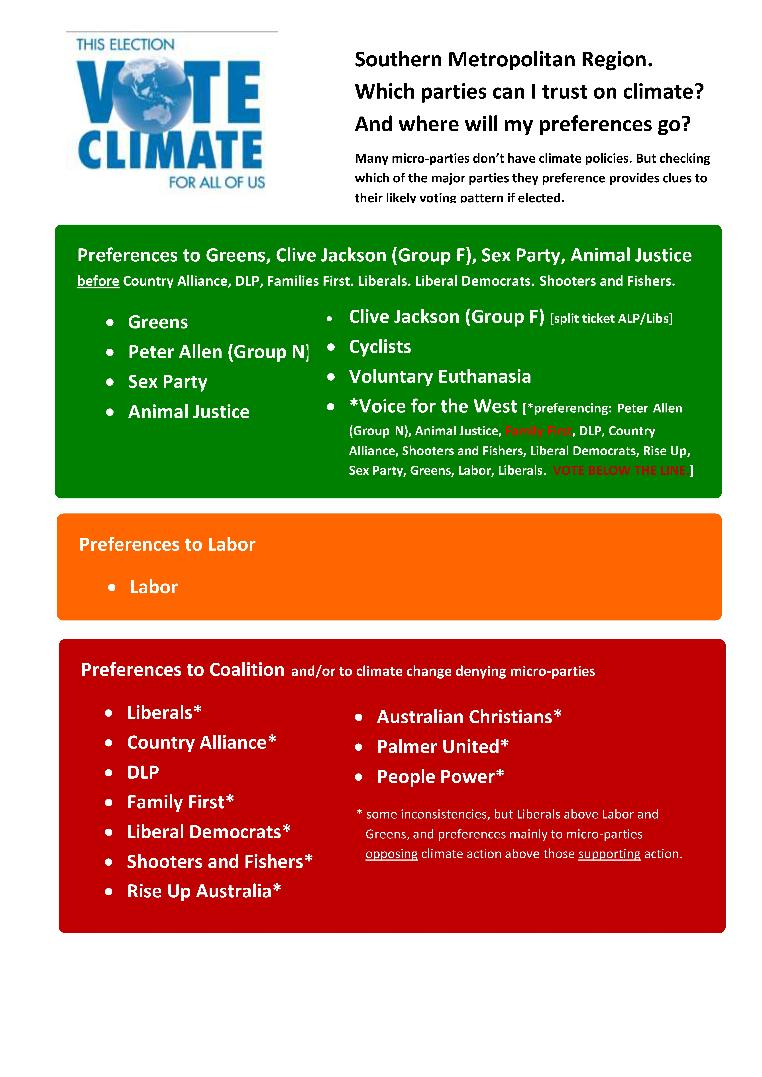Victorian election 2014 - climate policy summary
The table below compares the climate policies of the Liberals, Labor and Greens.
Unlike most scorecards, the Vote Climate scorecard compares the policies of the parties to the policies that are actually needed to solve the climate crisis. The colour code used below is red for bad climate policy, yellow for weak climate policy, and green for good climate policy.
More detail can be found by clicking the tabs in the menu above.
Preferencing guides
Scroll down for a guide to the preferencing of the parties and independents in Northern Metropolitan Region.
Other regions coming soon.

Note. Abbreviations - VEET is Victorian Energy Efficiency Target; VRET is Victorian Renewable Energy Target.
Find out more. Click on the tabs in the Vote Climate menu above to read more detailed policy summaries, have a look at Environment Victoria's Promise Watch, or go to MP Watch.
Northern Metropolitan Region preferences
Labor and Voice of the West preferences in Northern Metropolitan Region could give climate change denying Family First the balance of power in the Victorian upper house.
The diagram is a guide to 'above the line' preferencing in Northern Metro Region - the preferencing determined by the parties that you can't even see on the upper house ballot paper, and hence must take on trust.
Usually the result in Northern Metro is two ALP, two Liberals and one Greens (Greg Barber). However, a redistribution has meant that the second Liberal seat could go to a micro party - with the outcome uncertain, but Family First, the Sex Party and climate friendly independent Peter Allen (Group N) are all possibilities.
Those who vote above the line for Labor, or Voice of the West, probably wouldn't expect that their preferences could help elect climate change denying Family First to the fifth seat in Northern Metro.
The Labor Party preferences Family First, Country Alliance, the DLP and Liberal Democrats above climate friendly independent, Peter Allen (Group N).
Voice of the West preferences are also problematic. They preference Family First, the DLP, Country Alliance, Vote 1 Local Jobs, Shooters and Fishers, Australian Christians, Liberal Democrats, Rise Up Australia, and Palmer United all ahead of the Sex Party (which has a good climate policy, even though their focus is elsewhere), Greens and the Labor Party.
Palmer United Party preferences also flow to Family First and then to the Liberals ahead of the Greens and Labor, which may be a surprise to some.
The rest of the parties all allocate their preferences in ways that are internally consistent and presumably what voters would expect.
Climate friendly parties and candidates (such as Greens, Peter Allen (Group N) and Sex Party and Animal Justice Party) preference each other.
The rest of the progressive preference-swap grouping (Basics Rock ‘n’ Roll, Cyclists and Voluntary Euthanasia) also support climate friendly candidates.
The climate unfriendly parties (Liberals, Family First, Rise Up Australia, Country Alliance, Liberal Democrats and Shooters and Fishers) also generally preference each other although with a few inconsistencies, (marked on the chart with *).
The rest of the right wing preference-swap group (Australian Christians, People Power, and Vote 1 Local Jobs) also support climate unfriendly parties.

Southern Metropolitan Region preferences
It's unlikely there will be any changes in Southern Metropolitan Region this election, so preferences are less relevant. In any case, the preferences seem to flow pretty much as voters would expect.
According to Tally Room,the likely result in Southern Metropolitan Region is the same as last election - three Liberals, one Labor and one Greens.
"The first two Liberal seats and the single Labor seat are very safe, and the third Liberal seat and the Greens seat are also reasonably safe.
The Liberal vote is a long way away from putting the party’s fourth candidate in a possibly winning position. The party could see a drop in vote that could threaten their third seat, but it would have to be a substantial drop.
The Greens won their seat fairly comfortably. The ALP would need a swing of approximately 2.2% against the Greens to pick up a seat."
